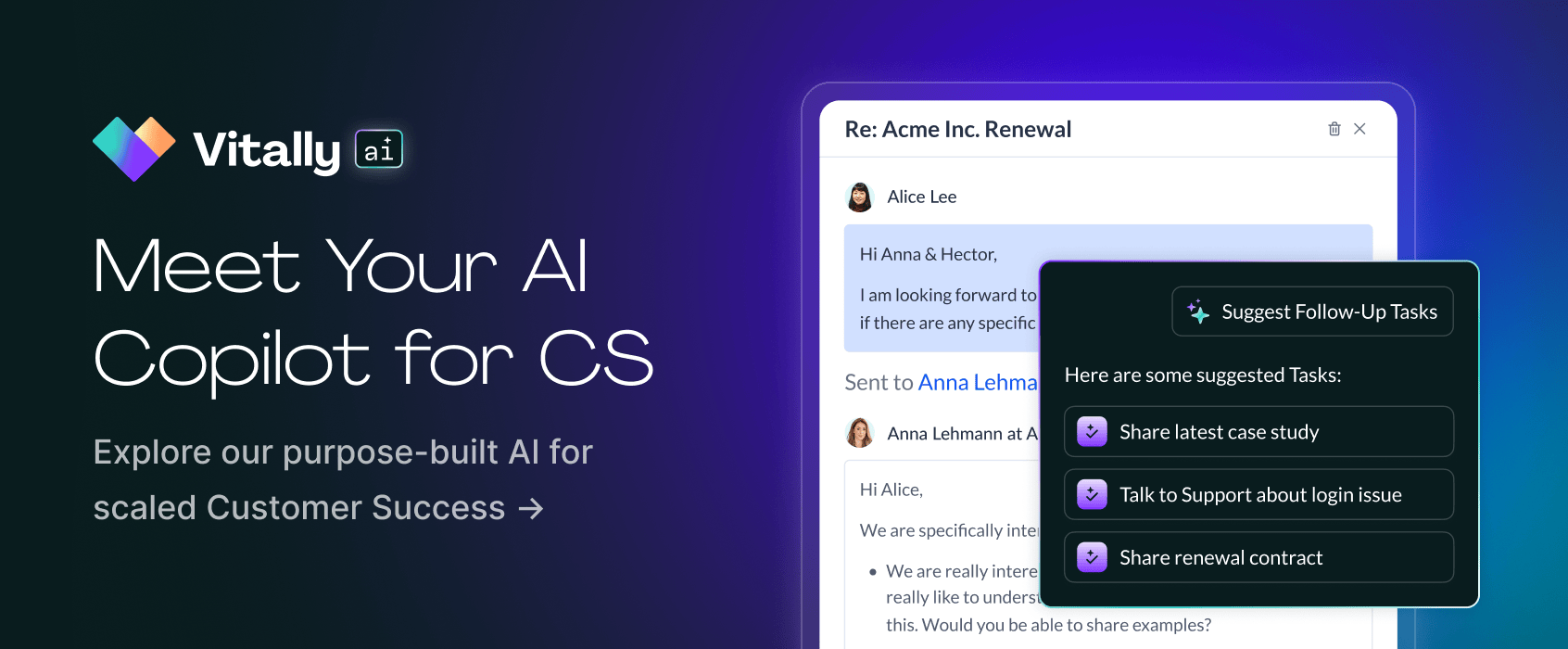
In today’s fast-evolving landscape, AI and automation are becoming indispensable tools for Customer Success teams. But what does it take to bring AI and automation together to significantly elevate the customer experience (CX)? I’d like to share my insights on effectively harnessing these technologies.
Understanding the Difference: AI vs. Automation
It's crucial to distinguish between AI and automation, terms that are often mistakenly used interchangeably. I like to describe AI as the "brains" and automation as the "hands" of a successful workflow. While AI encompasses advanced algorithms like natural language processing (NLP), machine learning (ML), and large language models (LLM) that process, categorize, and predict data, automation is about executing tasks — potentially powered by AI or simple API calls.
True AI, meaning creative or innovative intelligence, doesn’t exist today. What we call AI is really just a great prediction and relation engine. Thus, one really strong use case we can automate is AI-driven insights. For instance, AI can understand a support ticket’s context, while automation executes the next steps, whether that’s escalating a ticket or updating CRM data.
Synergy Between AI and Automation in CX Workflows
From my perspective, examining the customer journey is key to pinpointing where AI and automation can be most beneficial. Here are some key areas to consider:
- Pre-Sale Engagement: A bot can handle common inquiries such as company information, refund policies, and job openings, providing immediate answers and a seamless user experience, and engaging customers, visitors, or prospects in a more intuitive way.
- Post-Sale Support: AI can gauge the intent and sentiment behind customer queries, triggering appropriate automated responses such as setting fields, predicting churn, or sending notifications to leaders.
- Data Utilization: Leveraging AI insights and analytics tools helps identify trends in customer sentiment and gaps in service offerings, enhancing strategic decision-making.
However, we must be cautious not to over-rely on generative AI in emotionally sensitive situations such as healthcare or finance, where human empathy is irreplaceable. Moreover, it’s crucial to implement AI and automation in stages to avoid quality issues and AI hallucinations.
Related: 4 Customer Success Automations to Save Time and Boost Productivity

Real-World Applications and Success Stories
I’ve seen significant improvements with AI and automation in various scenarios:
- Tinder for Zendesk Tickets: With PixieBrix, I built an automation for Zendesk that read backlog tickets, generated responses using AI, and allowed agents to approve or escalate them. This streamlined the support process, saving time and improving efficiency.
- Automating Refund Processes: One of my clients used AI to manage refund requests by automating steps like order lookup, refund calculation, and customer communication. This process, which originally took 6-8 minutes, was reduced to under a minute, showcasing a remarkable improvement in efficiency.
Learn more: Tinder for Zendesk: Clearing your case backlog with PixieBrix & AI
Tools I Recommend for AI and Automation in CX
Several tools can help integrate AI and automation into CX processes:
Some of my favorite tools include TheLoops for AI insight and analytics, Kodif for workflow automation, and SienaCX for Conversational AI.
There are so many out there though. The biggest thing I recommend is to be very specific with your use cases when you go to market for an AI tool in CX. Really understand the problem you are trying to solve or the experience you want to create.
Overcoming Implementation Challenges
Implementing AI and automation comes with challenges like preventing AI hallucinations, optimizing data formatting, and managing workflows effectively. My advice is to hire experts or utilize vendor support to navigate these complexities, especially for customer-facing use cases. There are many examples out there where Generative AI has lead to incorrect policies or bad advice being shared, and this is due to the model not being implemented correctly or the solution wasn't fit for the purpose it was being deployed for.
Related: Proven Strategies for Cultivating Long-Term Adoption
The Future of CX with AI and Automation
AI is here to stay, and it will fundamentally change the way we interact with our customers. As the models improve, we will trust AI to handle more of our volumes and situations. Human-in-the-loop will remain incredibly important, but those humans will become more specialized in industry and business nuances. This will enhance the customer experience through more contextual and consultative conversations.
Wrapping Up: Start Small
Integrating AI and automation in Customer Success is not just a trend but a transformative technology that can redefine customer engagement. By starting small, building robust solutions, and utilizing the right tools, companies can significantly enhance their CX workflows.
By embracing AI and automation, Customer Success teams can not only streamline operations but also deliver superior, tailored experiences to their customers. My experience offers a road map for effectively harnessing these technologies for improved CX.









